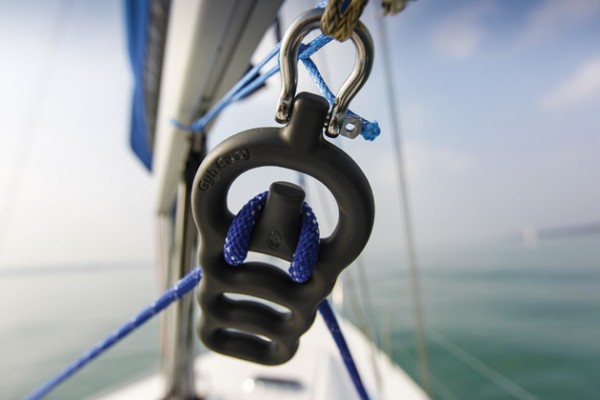Pip Hare tested this alongside the Walder boom brake and a traditional rope preventer for a comparison of boom brakes and preventers
Wichard Gyb’Easy tested
There are a number of solutions on the market to help control a gybe and minimise the effects of a crash gybe, but how practical, effective and relevant are they to the average cruising sailor?
With this in mind I borrowed a Dufour 385 and set out to test the Walder boom brake, the Wichard Gyb’Easy and the Sailfuse and compare them against a conventional gybe preventer set up with a long piece of line.
See here for the full comparative test
The day we chose to test these products I had doubts as to how much I would learn as there was very little wind and no chance for them to strain against the force of a fully loaded gybe. However, the benign conditions actually gave me a chance to get to grips with how each of them worked and assess how useful they would be in the everyday routine of a cruising sailor.
Installation and fitting
The first thing I considered was how easy each product was to fit and whether they could be permanently rigged or would have to be fished out of a locker every time they were required. There is often a reality gap between what we know we should do and what we actually do where effort is involved.
I wouldn’t want to leave the Gyb’Easy permanently installed, although it would be possible to unthread the control rope when not sailing downwind to allow the boom a free range of movement. This would leave the unit dangling unrestrained under the boom and a lazy rope lying on the deck, which I would not be happy about. I think the conventional rope preventer and the Gyb’Easy would be gear that is only rigged when sailing downwind.
There are two elements to setting up the Wichard Gyb’Easy. The friction that controls the speed at which the boom will swing during a gybe is created by passing the control rope through the unit. There are three possible settings: more turns create more friction. The boom is then held in place outboard by applying tension to the control rope on the lee side.
With just the right amount of friction and the leeward rope tensioned, the Gyb’Easy produces a slow and gentle gybe. However, this is entirely governed by how many turns the control rope takes through the device. With too many turns the boom is pinned out, which can only be corrected by letting the control rope go. Too few turns and the boom will still fly across the cockpit at speed.
When we set the Gyb’Easy up properly it did work well, but over the length of a passage in changing conditions you would need to leave the cockpit to thread or unthread friction to balance changes to sail size or conditions.
The Gyb’Easy comes with a Gyb’Flex control rope and the warning that performance is not guaranteed if a different rope is used. I presume this is down to optimum results requiring a rope of specific diameter/softness, but the rope supplied was not long enough to reach the cockpit winches on both sides of our Dufour 385.
How to fit
- Fit the Gyb’Easy on a fixed boom bale forward of the kicker. This was not possible on our test so we used Dyneema strops.
- Fix two blocks at deck level in line with the shroud base.
- Run the supplied Gyb’Flex rope from the cockpit, forward through one block, over the coachroof to the other and then back to the cockpit.
- Thread a bight of the control rope through the holes in the Gyb’Easy and over the stump at the top. Increase turns through the unit to increase friction.
Verdict
The one benefit the Wichard Gyb’Easy has over a regular rope preventer is that it can be set to allow a gentle gybe and not just to pin the boom out, which in itself can present a risk. However, I would not want to leave it permanently installed and it would need regular adjustment when conditions change




